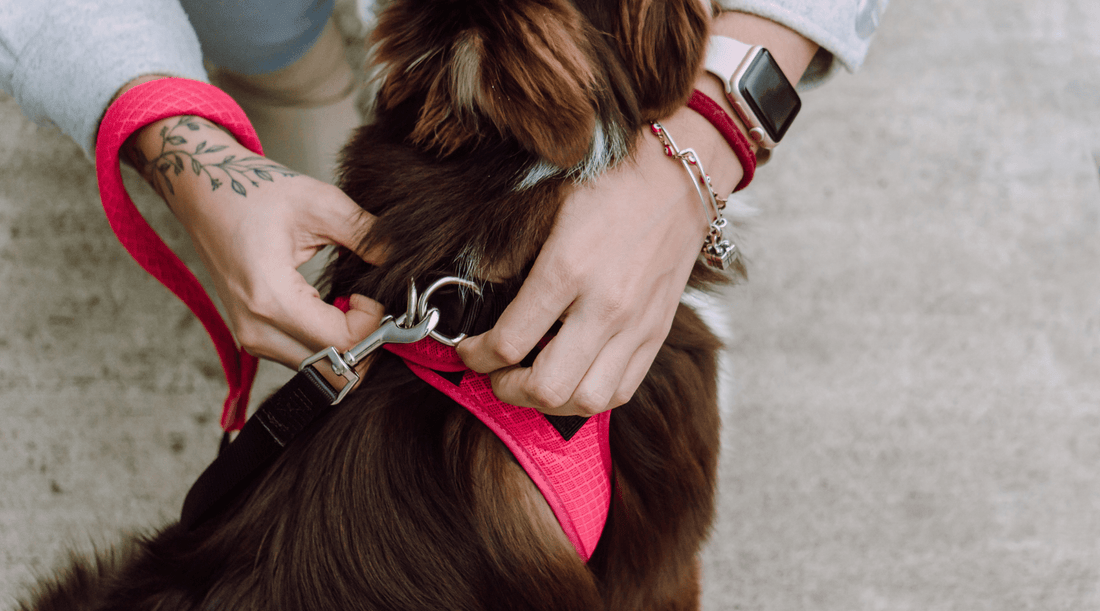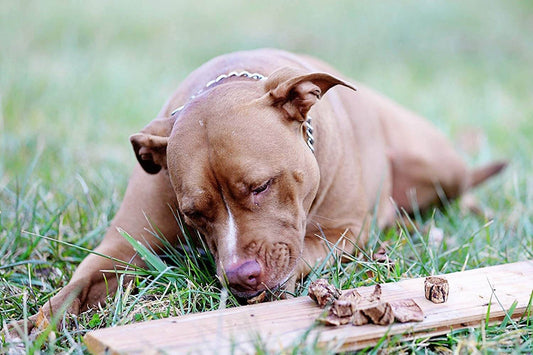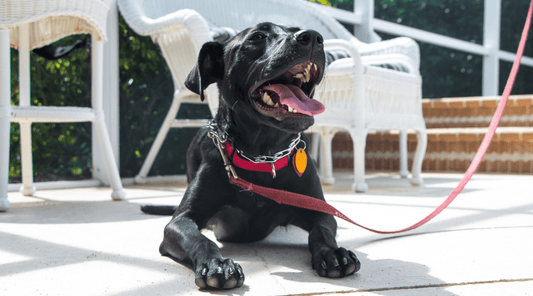
How to Put on a Dog Harness
Dawn Miller Apr 19, 20254 Minute ReadLearning how to put on a dog harness may have saved my relationship with my dogs.
It started with a squirrel.
I was holding Pixie’s leash, coffee in one hand, when she spotted it. One fluffy-tailed flash. And she yanked so hard I almost spilled my entire morning jolt down my pant suit. And let's just say, the coffee wasn't lawsuit-level hot, but it left my skin splotchy for a few days.
This was a few years ago. But after this little squirrel-coffee fiasco, I made the switch to a harness.
And let me tell you—it made a huge difference. But only after I figured out how to actually put the thing on without turning it into a doggy wrestling match.
If you’ve ever fumbled with loops and clips, or you think harnesses are just too complicated to be practical for daily walks, this post is for you.
Why Use a Harness Instead of a Collar?
Sure, collars are classic. Pixie looks like a diva in her purple bejeweled neckpiece we got her off Etsy. But harnesses offer a whole different level of control and safety, especially for distractible dogs that pull.
They're also gentler on the neck and throat, which matters a lot if your pup likes to lunge at...well, anything that moves.
Before You Start: Get the Right Fit
Some wrap around the chest. Others slide over the head. A few make you question your engineering degree.
Before you start buckling and adjusting, make sure you’ve got the best dog harness for your pup’s size and needs. And no, that cute one with the cute cactus print doesn’t count if it digs into their armpits like an actual cactus would. Harnesses are adjustable.
So, just get in the general vicinity with XXS, S, M, L, XL sizes and then start adjusting the straps to get the right size. Once you get it right, you won't have to do it again for a while.
How Tight Should a Dog Harness Be?
You want it snug but not restrictive. Use the two-finger rule you would use with a dog collar. You should be able to slip two fingers between the harness and your dog’s body.
Too loose, and your dog can wiggle free. Too tight, and they’ll be uncomfortable and cranky. (Kinda like us after a long day in skinny jeans.)
How to Fit a Dog Harness (Without Losing Your Cool)
Step 1: Pick the Right Style
Step-in harness (ideal for calmer dogs or those already trained). You will teach them the "Step In" command to make getting dressed a breeze. Use high-value dog treats and they'll learn fast.
Here's a nice, inexpensive step-in harness on Amazon that reviewers like.
Over-the-head harness (great for dogs who trust you without fail). Dogs may otherwise duck and squirm if you try to put something over their head. They will need to know the "Sit", "Calm" or "Stay" command to put their mind at ease while you pull the harness over their head. Reward them with a treat and praise when they stay calm.
Here's a reflective and padded over-the-head harness on Amazon.
Front-clip options (great for controlling pulling). I prefer front clip harnesses. They allow you to redirect your pup automatically. If they try to pull forward, the harness guides them to the side, slowing their momentum.
Back-clip / top clip options (only appropriate for tiny dogs). Back clipping a harness risks damaging your dog's neck or shoulders if you accidentally pull too hard. If it doesn't cause harm, it does build back and chest muscles, which can be counterproductive to your goal of smoother walks.
To me, a back clip defeats the purpose of a harness because it doesn't restrict their forward momentum. If they want to pull you like a dog sled, they can with a back clip.
If you're a visual person like me, Amanda actually shows why front-clipping at the chest works better than the back in her YouTube video.
Worth a watch if your pup acts like they were raised by a plow ox sometimes.
Step 2: Practice Sit and Stay (The Dog, Not You)
Get your pup calm with a simple “sit.” Reward them for their calmness with a single-ingredient dog treat. I use beef lung bites.
And sometimes I give them a dog bone for 10-15 minutes before our walk. Chewing on dog bones, especially nutritious marrow bones, is very relaxing for a dog. It can help them approach the harness more calmly.
Step 3A: Use "Step in" Command
If you choose a step-in harness, lay the harness on the floor. Open up the spaces where their front legs go. Say "step in." Once trained, your dog will step into the openings. You can then pull the harness around them and latch it. Reward them with praise or another treat for staying calm.
After practicing a few times, this takes all of a couple of seconds. No squirming. That's the power of positive reinforcement dog training.
Step 3B: Use the "Calm" Command
If you choose an over-the-head harness, then "sit" or "calm/quiet" command can do the trick. Reward them for calm behavior.
Building trust with your dog is essential for this to work. Some of these harnesses are padded, which means they're bulky. Your dog may think you're putting a bag over their head if they don't trust you.
But this is something you can work on. Reward-based training with treats and praise builds trust. Dogs learn to understand what you want. You seem more predictable. And they begin to associate good feelings with following commands.
Step 4: Adjust the Fit
Use that two-finger technique under each strap. Adjust the fit if needed. And you're out the door in minutes.
Double-check for freedom of movement once you're outside. They should be able to walk, run, and jump a little.
Getting Your Dog Used to the Harness
Some pups will freeze. Others will flop. And some—like Pixie—will do that sideways crabwalk like the harness is made of lava the first time you put it on. Others might gnaw at a strap.
This is normal dog curiosity in action.
Use positive reinforcement techniques to reassure them and to help them associate the harness with good things to come (a fun walk).
Here are some quick tips.
- Use a cheerful voice to command them to "sit", "stay", or "step in".
- Give your dog a treat each time you put on the harness.
- Praise them like they just won Best in Show.
- Do short practice sessions before heading out.
- Teach them the "let's go" command to communicate when it's time to start the walk. Hold a treat in your hand at your side. Guide your dog with their nose as you begin walking together. Give them the treat when they stay at your side.
- Never use the harness to yank them. When you front clip, you can gently redirect a large dog without force.
Whether your pup’s still fighting the harness or you're ready to learn more about positive reinforcement training, the 7-Day Dog Training Challenge can help you and your dog work together and avoid most squirrel-related coffee spills on walks.
Available On:


Disclosure: This article may contain affiliate links, which means we may earn a small commission if you make a purchase through these links—at no extra cost to you. We only recommend products we trust and believe will benefit you and your K9.



